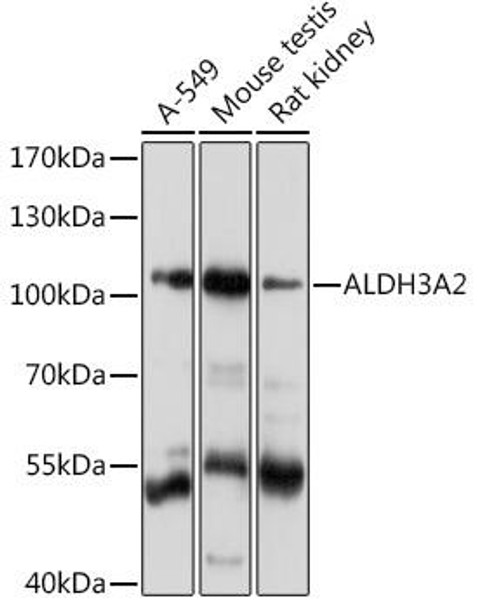Anti-ALDH3A2 Antibody (CAB16267)
- SKU:
- CAB16267
- Product type:
- Antibody
- Reactivity:
- Human
- Mouse
- Rat
- Host Species:
- Rabbit
- Isotype:
- IgG
- Antibody Type:
- Polyclonal Antibody
- Research Area:
- Metabolism
Description
| Antibody Name: | Anti-ALDH3A2 Antibody |
| Antibody SKU: | CAB16267 |
| Antibody Size: | 20uL, 50uL, 100uL |
| Application: | WB IF |
| Reactivity: | Human, Mouse, Rat |
| Host Species: | Rabbit |
| Immunogen: | Recombinant fusion protein containing a sequence corresponding to amino acids 250-320 of human ALDH3A2 (NP_001026976.1). |
| Application: | WB IF |
| Recommended Dilution: | WB 1:500 - 1:2000 IF 1:50 - 1:100 |
| Reactivity: | Human, Mouse, Rat |
| Positive Samples: | A-549, Mouse testis, Rat kidney |
| Immunogen: | Recombinant fusion protein containing a sequence corresponding to amino acids 250-320 of human ALDH3A2 (NP_001026976.1). |
| Purification Method: | Affinity purification |
| Storage Buffer: | Store at -20°C. Avoid freeze / thaw cycles. Buffer: PBS with 0.02% sodium azide, 50% glycerol, pH7.3. |
| Isotype: | IgG |
| Sequence: | EASL QNQI VWKI KETV KEFY GENI KESP DYER IINL RHFK RILS LLEG QKIA FGGE TDEA TRYI APTV LTD |
| Gene ID: | 224 |
| Uniprot: | P51648 |
| Cellular Location: | Cytoplasmic side, Endoplasmic reticulum membrane, Single-pass membrane protein |
| Calculated MW: | 54kDa/57kDa |
| Observed MW: | 55kDa |
| Synonyms: | ALDH3A2, ALDH10, FALDH, SLS |
| Background: | Aldehyde dehydrogenase isozymes are thought to play a major role in the detoxification of aldehydes generated by alcohol metabolism and lipid peroxidation. This gene product catalyzes the oxidation of long-chain aliphatic aldehydes to fatty acid. Mutations in the gene cause Sjogren-Larsson syndrome. Alternatively spliced transcript variants encoding different isoforms have been found for this gene. |
| UniProt Protein Function: | ALDH3A2: Catalyzes the oxidation of long-chain aliphatic aldehydes to fatty acids. Active on a variety of saturated and unsaturated aliphatic aldehydes between 6 and 24 carbons in length. Responsible for conversion of the sphingosine 1-phosphate (S1P) degradation product hexadecenal to hexadecenoic acid. Defects in ALDH3A2 are the cause of Sjoegren-Larsson syndrome (SLS). SLS is an autosomal recessive neurocutaneous disorder characterized by a combination of severe mental retardation, spastic di- or tetraplegia and congenital ichthyosis (increased keratinization). Ichthyosis is usually evident at birth, neurologic symptoms appear in the first or second year of life. Most patients have an IQ of less than 60. Additional clinical features include glistening white spots on the retina, seizures, short stature and speech defects. Belongs to the aldehyde dehydrogenase family. 2 isoforms of the human protein are produced by alternative splicing. |
| UniProt Protein Details: | Protein type:Carbohydrate Metabolism - propanoate; Amino Acid Metabolism - histidine; Membrane protein, integral; Oxidoreductase; EC 1.2.1.3; Amino Acid Metabolism - lysine degradation; Carbohydrate Metabolism - ascorbate and aldarate; Carbohydrate Metabolism - pyruvate; Carbohydrate Metabolism - butanoate; Other Amino Acids Metabolism - beta-alanine; Lipid Metabolism - fatty acid; Amino Acid Metabolism - arginine and proline; Secondary Metabolites Metabolism - limonene and pinene degradation; Lipid Metabolism - glycerolipid; Carbohydrate Metabolism - glycolysis and gluconeogenesis; Amino Acid Metabolism - tryptophan; Amino Acid Metabolism - valine, leucine and isoleucine degradation; Mitochondrial Chromosomal Location of Human Ortholog: 17p11.2 Cellular Component: endoplasmic reticulum membrane; intracellular membrane-bound organelle; mitochondrial inner membrane; integral to membrane; peroxisome Molecular Function:long-chain-alcohol oxidase activity; aldehyde dehydrogenase (NAD) activity; aldehyde dehydrogenase [NAD(P)+] activity; 3-chloroallyl aldehyde dehydrogenase activity; long-chain-aldehyde dehydrogenase activity Biological Process: phytol metabolic process; epidermis development; central nervous system development; aldehyde metabolic process; sesquiterpenoid metabolic process; peripheral nervous system development Disease: Sjogren-larsson Syndrome |
| NCBI Summary: | Aldehyde dehydrogenase isozymes are thought to play a major role in the detoxification of aldehydes generated by alcohol metabolism and lipid peroxidation. This gene product catalyzes the oxidation of long-chain aliphatic aldehydes to fatty acid. Mutations in the gene cause Sjogren-Larsson syndrome. Alternatively spliced transcript variants encoding different isoforms have been found for this gene. [provided by RefSeq, Jul 2008] |
| UniProt Code: | P51648 |
| NCBI GenInfo Identifier: | 1706379 |
| NCBI Gene ID: | 224 |
| NCBI Accession: | P51648.1 |
| UniProt Secondary Accession: | P51648,Q6I9T3, Q93011, Q96J37, |
| UniProt Related Accession: | P51648 |
| Molecular Weight: | 485 |
| NCBI Full Name: | Fatty aldehyde dehydrogenase |
| NCBI Synonym Full Names: | aldehyde dehydrogenase 3 family, member A2 |
| NCBI Official Symbol: | ALDH3A2 |
| NCBI Official Synonym Symbols: | SLS; FALDH; ALDH10 |
| NCBI Protein Information: | fatty aldehyde dehydrogenase; aldehyde dehydrogenase 10; microsomal aldehyde dehydrogenase; aldehyde dehydrogenase family 3 member A2 |
| UniProt Protein Name: | Fatty aldehyde dehydrogenase |
| UniProt Synonym Protein Names: | Aldehyde dehydrogenase 10; Aldehyde dehydrogenase family 3 member A2; Microsomal aldehyde dehydrogenase |
| Protein Family: | Fatty aldehyde dehydrogenase |
| UniProt Gene Name: | ALDH3A2 |
| UniProt Entry Name: | AL3A2_HUMAN |




![Anti-ALDH3A2 Antibody (CAB19899)[KO Validated] Anti-ALDH3A2 Antibody (CAB19899)[KO Validated]](https://cdn11.bigcommerce.com/s-39x6lpnvxv/images/stencil/590x590/products/21582/19782/anti-aldh3a2-antibody-cab19899ko-validated__29478__62717.1644252660.jpg?c=1)



